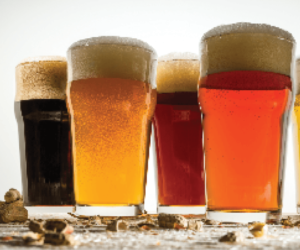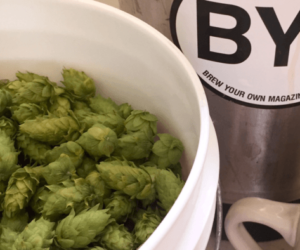Hold the Alcohol

Have you noticed non-alcoholic beers are increasing in popularity? Whether it’s for the more health-focused drinker, the pregnant woman who misses her IPAs, or the friend who’s offered to be the designated driver; there’s no doubt the demand for these types of products are on the rise. Looking at the current shelf, not only can you can find a variety of beers in the non-alcoholic (NA) category, but there is a growing movement for non-alcoholic spirits as well. These types of beverages have been popular internationally for quite some time, largely due to very strict driving under the influence laws. The craft NA space is filling up with more exotic styles, some with only hops and water or even some with THC (tetrahydrocannabinol) infusions.
In 2019 the Great American Beer Festival brought the non-alcohol beer category back to judge due to this increase in brands. And while, traditionally, the NA space on the shelf has largely been monopolized by the “big guys,” with most of the examples falling into the light lager category, slowly but surely IPAs and the like are popping up.
How the Big Breweries Usually Create NA Beer
To be considered “non-alcoholic” in the United States a beer must contain less than 0.5% ABV. Adjacent to that, “low-alcohol” beers are under 3% ABV. Larger breweries more commonly make these beers with some pricey equipment. One methodology commonly used is a membrane filtration of the beer. This membrane specific for this process is similar to reverse osmosis. Alcohol and water are separated, and the beer is concentrated. Water is added back to the beer concentrate to produce a non-alcoholic beer. The main concern with membrane filtration is a lot of the flavor can be stripped along with the alcohol, but this process still can produce some of the best results. Given the costs associated with it, this process is likely not an option to try at home but is an important part to understand how the majority of these commercial products are designed.
A second method that produces a beer with less than 0.5% alcohol is vacuum distillation. This is a method in which the beer is heated and the alcohol is removed via the distillation process. The vacuum lowers the boiling point of the alcohol from 173 °F (78 °C) to 93 °F (34 °C). This is a great way to reduce a beer to 0.5% alcohol, but can produce a beverage with a less than desirable flavor. The heating process can exacerbate off-flavors typical of beer that has been oxidized or with autolysis, even with the lower boiling point.
More Reasonable Small-Scale NA Methods
There are a handful of approaches that homebrewers and small-scale brewers can attempt to create NA and low-alcohol beer that doesn’t require expensive equipment out of their reach. One method of crafting a beer with low alcohol is arresting a fermentation and/or beginning with a low OG. This is commonly done in winemaking to control alcohol levels and retain some of the fermentable sugars to result in a sweeter wine. This method can be difficult to control, as you need to watch the fermentation closely. It does not take long to ferment wort to 0.5% ABV — maybe 12–36 hours. A gravity drop from 1.016 to 1.012 will result in a 0.53% ABV beer based on calculations. Once it gets close to the desired alcohol content, the fermenter is rapidly chilled to stop the fermentation. In order to get this right, you’ll need to play around with recipes ranging with starting gravities around 1.015–1.020. Brewing a wort with a traditional gravity will result in a beer that is way too sweet if fermentation is halted so early. With this method there are a large percentage of residual fermentables, so bottle conditioning is not an option.
Beyond these approaches, one could consider the style to be brewed to achieve NA beer. A common product in the Caribbean and Africa is Malta, or what could be described as wort soda. It’s essentially carbonated, unfermented wort. The amount of hops is usually relatively low, if hops are added at all. It’s often poured over ice or mixed with condensed milk. The origin of this product was a low-ABV beer and then later became a non-alcoholic product. One of the main selling points of this type of product is that it is truly 0.0% ABV. For someone that doesn’t want to consume even 0.5% alcohol, this could be a good option. A homebrewer could easily make this type of beverage, keeping in mind that it would be relatively unstable with lots of fermentable sugars. Sanitation and refrigeration would be necessary without pasteurization or preservatives. It’s also worth noting that while this product would work for that “dry January” New Year’s resolution, it would not be recommended if your resolution was cutting carbs!
Altering the recipe or fermentation of a beer can be a good way to obtain low-ABV beers, although achieving less than 0.5% can still be difficult. The first method would be altering the mash profile. A typical wort is primarily fermentable sugars (see Figure 1 for an example wort). Ideally, a wort with at least 75% unfermentable sugars are necessary for low-alcohol beers fermented traditionally (see Figure 2 for an example). Increasing or decreasing the mash temperature can create less fermentable sugars such as maltose and glucose by controlling the enzymatic activity of the malt. Increasing the mash temperature will decrease the enzymatic activity of the malt and reduce the amount of fermentable sugars. Decreasing the temperature will increase enzymatic activity and therefore the fermentable sugars. Holding the mash temperature above 158 °F (70 °C) will create more dextrins. This approach can produce a successful low-alcohol beer, but can also create a “worty” flavor and aroma. Typically these dextrins aren’t perceived as sweet as other sugars, which can help establish body for the beer without being overly sweet.
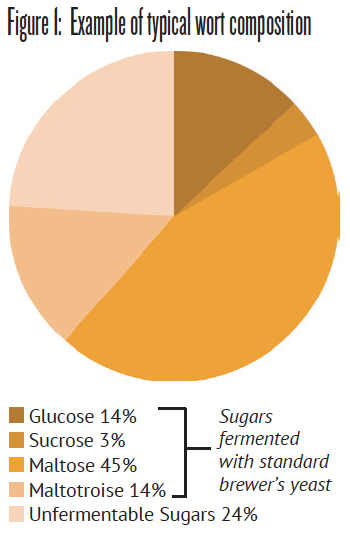
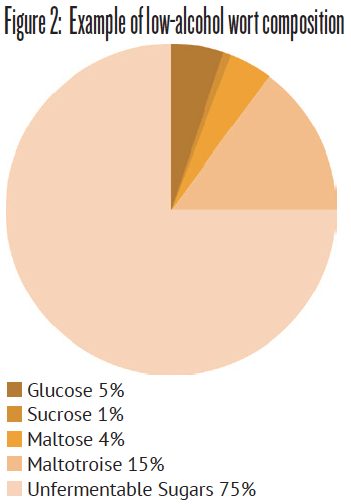
Cold mashing is another option in which the temperature of the mash is below starch gelatinization. Blending with water and increasing carbonation are approaches you can work on to combat the “worty” flavor.
Low-Alcohol Yeasts
Low-alcohol yeasts are a newer topic in the production of low-alcohol beer. Many of these are non-Saccharomyces strains that cannot ferment maltose or maltotriose. They would be referred to by a lab or scientist as “maltose-negative” strains.
All of these strains are non-GMO, although some GMO strains do exist. Examples of low-ABV strains that can be used in these types of fermentations are in Chart 1.
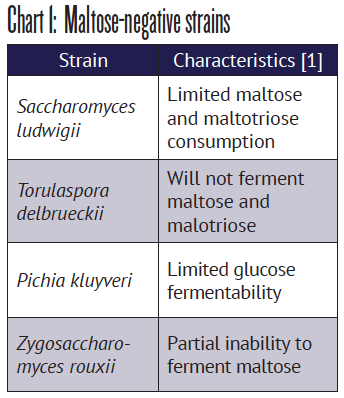

These strains can have positive contributions to flavor, such as increased esters, while keeping the fermentation of fermentable sugars low. These will produce beers with an alcohol percentage around 1–1.5% ABV depending on strain and wort recipe. Using these yeasts will certainly require a certain level of research and development to obtain a delicious, low-ABV beer that can compete with products currently on the market. At White Labs, where I am the Head of Laboratory Operations, we have several of these strains available for homebrewers in our Vault.
Pitching rates of these strains can be expected to be lower, as the amount of sugar to be fermented is low. If the recipe is only fermenting, for example, from 1.016 to 1.012, the fermentation doesn’t need many cells to do the job. Therefore pitching rates for these beers from lab-grown cultures range from 300–500 million cells/mL. It’s less likely that you need a starter for any of these cultures and more likely to cross contaminate the starter with brewer’s yeast strains.
Sanitation is important with any of these products. Without all of the alcohol as a protection and lots of nutrients in the beer, it is necessary to ensure that the pH is low enough. It is recommended that the pH be under 4.6 to be considered an acidified food, which eliminates most food pathogens. These maltose-negative yeast strains are regarded as wild yeast but would not be considered beer spoilers. Their inability to ferment larger sugars prevents them from being categorized as such. With the amount of sugar and nutrients left in the beer, keeping everything clean is important and even then it is recommended to only keg these beers due to the very real possibility of exploding bottles. Packaging breweries are advised not to package beer without pasteurization, preferably with a tunnel. For home-
brewers, simply avoid bottling.
A Final Word
Regardless of the process of choice to make your low-alcohol beer, experimentation and blending is often an important part of getting the right flavor and aromas. It could take many recipes to dial in a desired flavor and aroma profile. Too much alcohol production can result and the need to blend with another batch, wort, or water could be possible.
Overall, there are many different approaches to low-alcohol beers depending on your homebrewing setup and interests. If you’re not sure you’re ready to experiment with mash temperatures and alternative strains there are some beer-inspired creations you can play with. Malta or sparkling hop water can be made at home easily. Play around with the hop water — adding some citric acid to change the mouthfeel or adding your favorite cocktail bitters to pack a tannic punch can be fun.
Hop Water (sidebar written by Don Osborn)
If you love brewing and drinking beer, there’s a good chance you enjoy the flavor and aroma of hops. Of course, there are times when even the biggest beer lovers among us aren’t reaching for a glass of suds. Even non-alcoholic beer may not be what you want to reach for in certain circumstances, which brings us to hop water —a sparkling, non-alcoholic beverage that can hit the spot any time of the day.
There is not an overabundance of information about making hop water available and while I will suggest a couple possibilities, feel free to experiment. There are a few commercial examples you can purchase but if you are reading BYO you might prefer to make your own. Lagunitas Hop Refresher is possibly the most commonly available commercial example. I first had hop water at Third Space Brewing in Milwaukee, Wisconsin and it was surprisingly enjoyable. After reading what little information I could find and watching the helpful Clawhammer Supply hop water video on YouTube, I gave it a shot (find my first attempt documented on YouTube by searching for “donosborn hop water.”)
The basic process is to boil the desired amount of water for 10 minutes. This sanitizes and de-oxygenates the water. Allow the water to cool to 170 °F (77 °C) and add lemon juice to bring the pH to 4.6 or lower. If you don’t have a pH meter or pH strips, don’t worry. In the Clawhammer video, one medium squeeze of lemon juice concentrate in their 1-gallon (4-L) batch was sufficient to bring the pH into an acceptable range.
When the water has cooled, it’s time to add the hops of your choice. My recommended addition rate is 2 g per gallon (0.5 g/L), however you may decide that more or less hits the spot for you. Like the addition rate, the hop variety is also up to you. Perhaps you want to stick with a lower alpha acid variety to limit bitterness, but you can experiment. If there is a hop (or hop combination) that you really like the aroma and character of, go for it. Otherwise, whatever you have on hand will work. You do not need much. The people I have talked to and seen make hop water most often use hop pellets or Cryo® powder but you can even use whole flowers (if you grow your own hops, you could even try a wet hop water) or hop extract. Let the hops steep for about 20 minutes. Filter out the hop material with hop bags or cheesecloth when packaging.
Hop water is carbonated as the spritzy bubbles make it a more enjoyable drink. There isn’t really a way to naturally carbonate this that I have seen, so you will need a kegging system to force carbonate. I have a very small keg that I use but you could either go all in on a 5-gallon (19-L) batch or just put a couple gallons (8 L) in a regular-sized homebrew keg. The carbonation level should be higher than it is for beer. Think soda or sparkling water CO2 volume level and you are on the right track. You can adjust to your preference.
Allow me to shift gears momentarily. There is not a single right way to make hop water. A friend of mine talked to his local brewery about their process. They boil the water for 10 minutes and add brewing salts as desired. They transfer the cooled water to a sanitized container and add hops at a rate of about 1⁄2 oz. per gallon (3.5 g/L. After two days of sitting at room temperature they remove/filter the hops and package. This also makes a nice hop water and is very different than the process I have followed.
Hop water might have a light greenish, cloudy tint. It should smell like hops and have a detectable bitterness. As homebrewers we like to be creative and we like variety. This is yet another beverage we can make at home for little to no cost and provide a unique, non-alcoholic option.
Low Alcohol Pilsner
(5 gallons/19 L all-grain)
OG = 1.016 FG = 1.013
IBU = 19 SRM = 2 ABV = 0.5%
Ingredients
3 lbs. (1.36 kg) German Pilsner malt
3.2 oz. (91 g) wheat malt
3.2 oz. (91 g) Carapils® malt
4.5 AAU Hallertau Mittelfrüh hops (60 min.) (1 oz./28 g at 4.5% alpha acids)
4.5 AAU Hallertau Mittelfrüh hops (10 min.) (1 oz./28 g at 4.5% alpha acids)
White Labs WLP306 (Torulaspora delbrueckii) or SafAle LA-01
Step by step
Strike in with a very thin mash, roughly 2 qts./lb. (4.2 L/kg). This is a single infusion mash performed for 60 minutes at 162 °F (72 °C). Begin lautering by raising to mash out at 170 °F (77 °C). An infusion of boiling water is recommended for rapid termination of enzymatic activity. Sparge with enough water so that you are not exceeding 1.5x the amount of initial strike water used between the boiling infusion and sparge water. Top up your kettle to 6 gallons (23 L) with water. Bring wort to a boil. Total boil time is 60 minutes. Add the first hops just after boil is achieved. Add the second hop addition with 10 minutes remaining in the boil.
Chill the wort down to 50 °F (10 °C) and pitch the yeast. Hold at this temperature for one week then check the gravity. If gravity is stable, move the beer to a lager vessel and reduce the temperature to 34 °F (1 °C). Hold at this temperature for two weeks. Keg and force carbonate to 2.8 v/v.
Low Alcohol Pilsner
(5 gallons/19 L extract only)
OG = 1.016 FG = 1.013
IBU = 19 SRM = 2 ABV = 0.5%
Ingredients
1.8 lbs. (0.82 kg) Pilsen dried malt extract
4.5 AAU Hallertau Mittelfrüh hops (60 min.) (1 oz./28 g at 4.5% alpha acids)
4.5 AAU Hallertau Mittelfrüh hops (10 min.) (1 oz./28 g at 4.5% alpha acids)
White Labs WLP306 (Torulaspora delbrueckii) or SafAle LA-01
Step by step
Heat 3 gallons (11.4 L) of water in your kettle. Once boil is achieved, remove from heat and stir in the malt extract and add the hops. Return to heat and follow the remaining boil, fermentation, and packaging instructions from the all-grain recipe.
References
1 Capece, A.; Romaniello, R.; Siesto, G.; Romano, P. Conventional and Non-Conventional Yeasts in Beer Production. Fermentation 2018, 4, 38.
Other recommended resources
• MBAA Podcast Episode 172: What’s the Buzz: Non-alcoholic Beer Production.
• Briess technical paper: Cold Extraction of Malt Components and their use in Brewery Applications.

